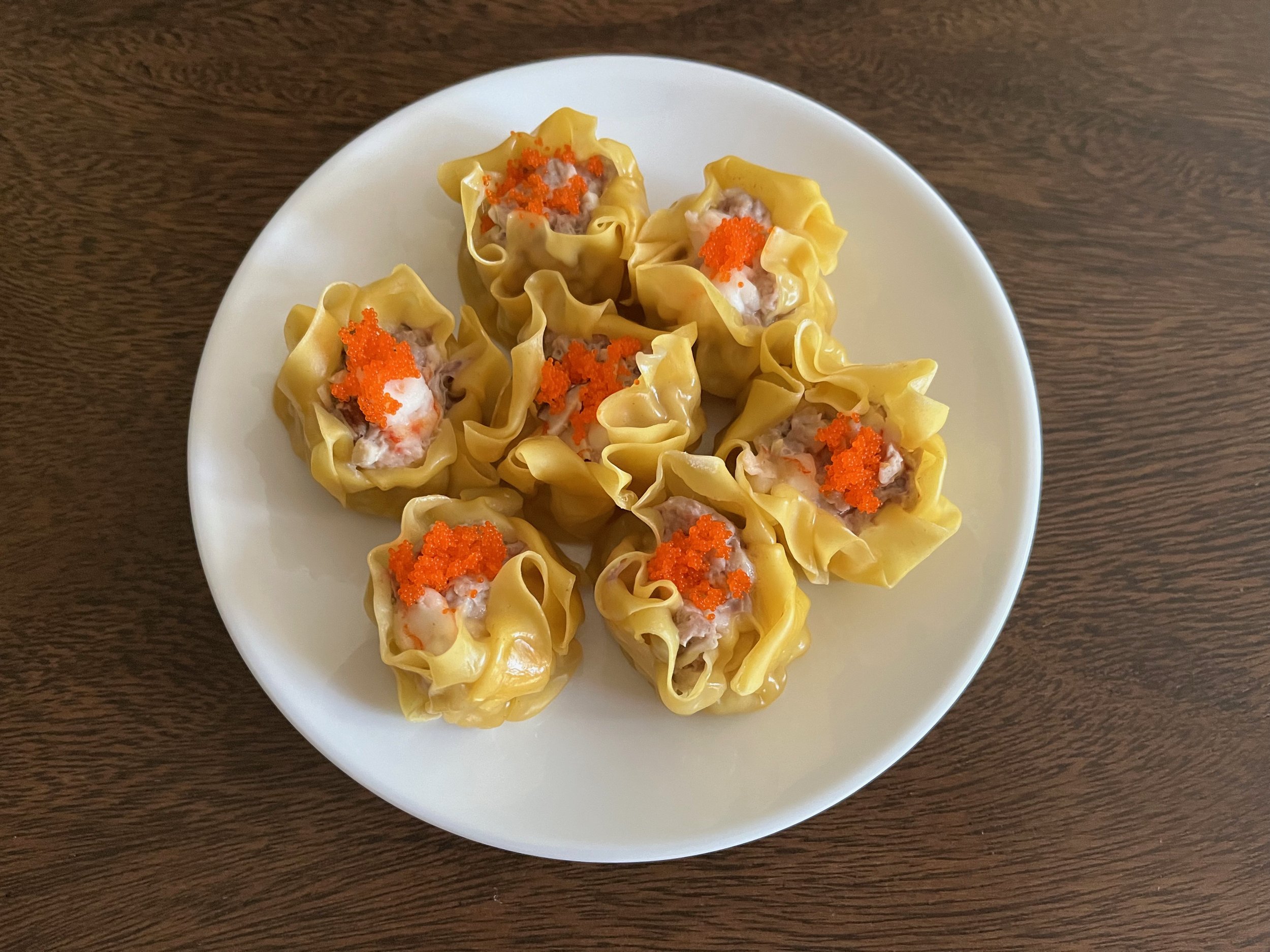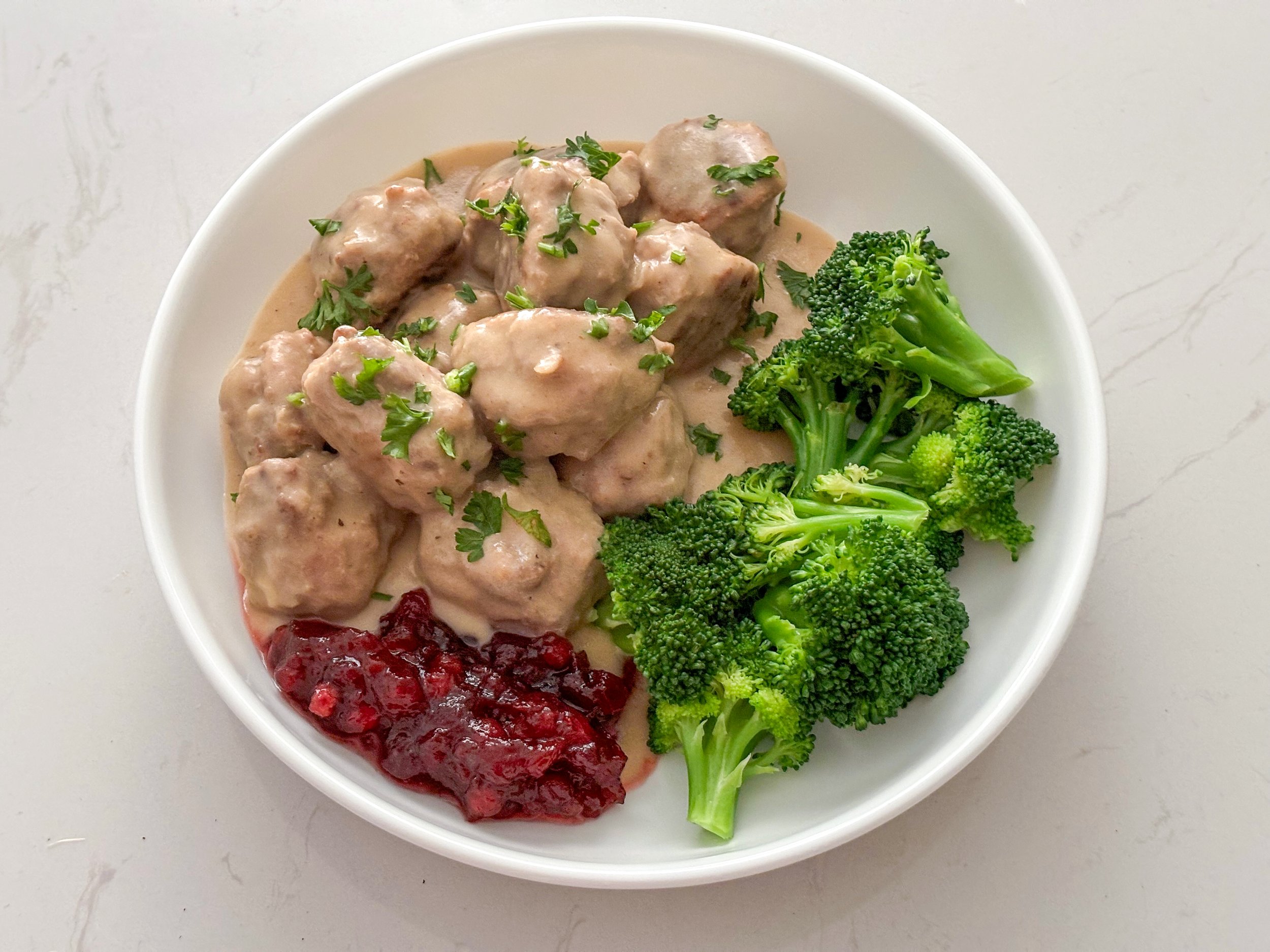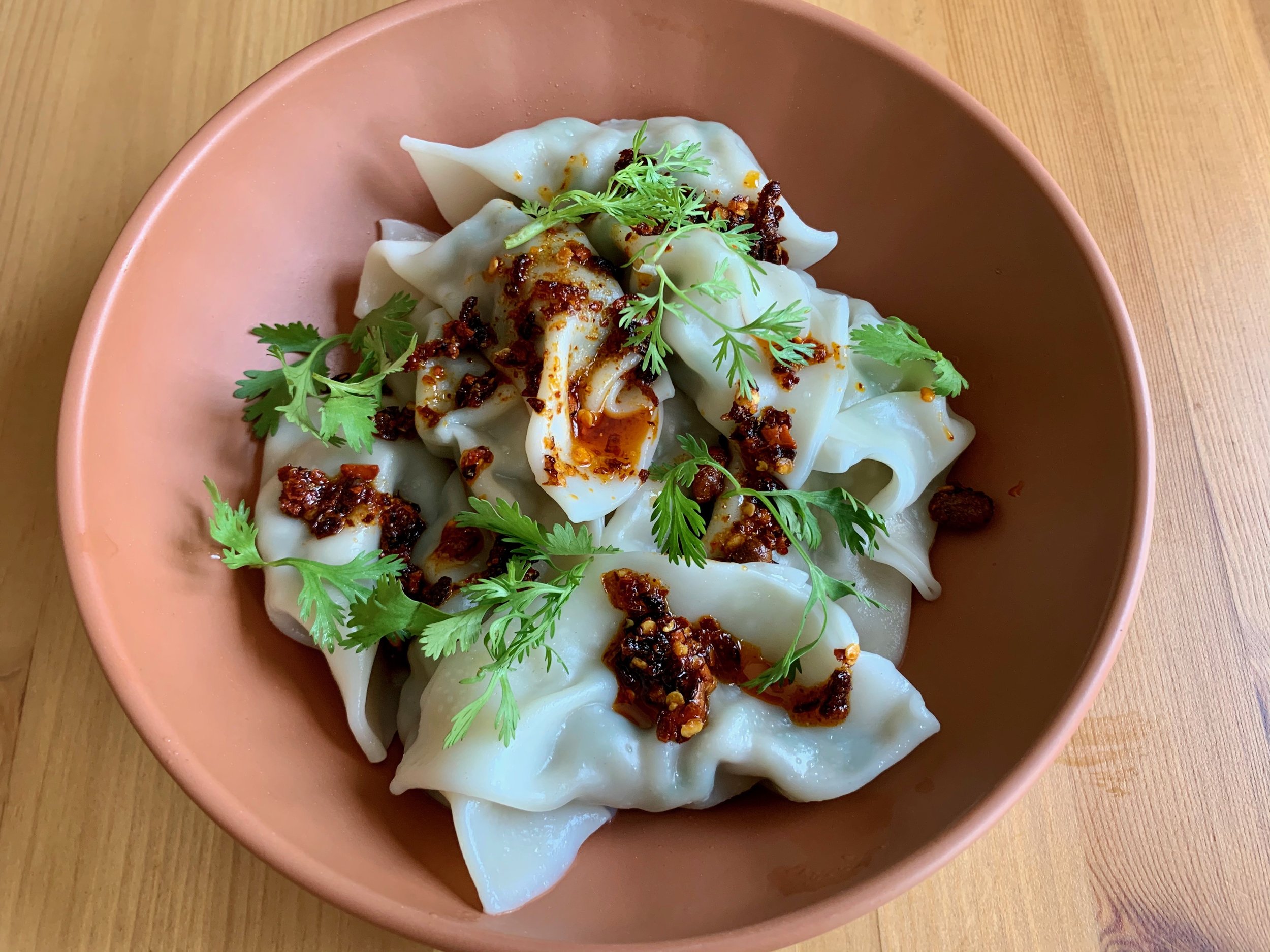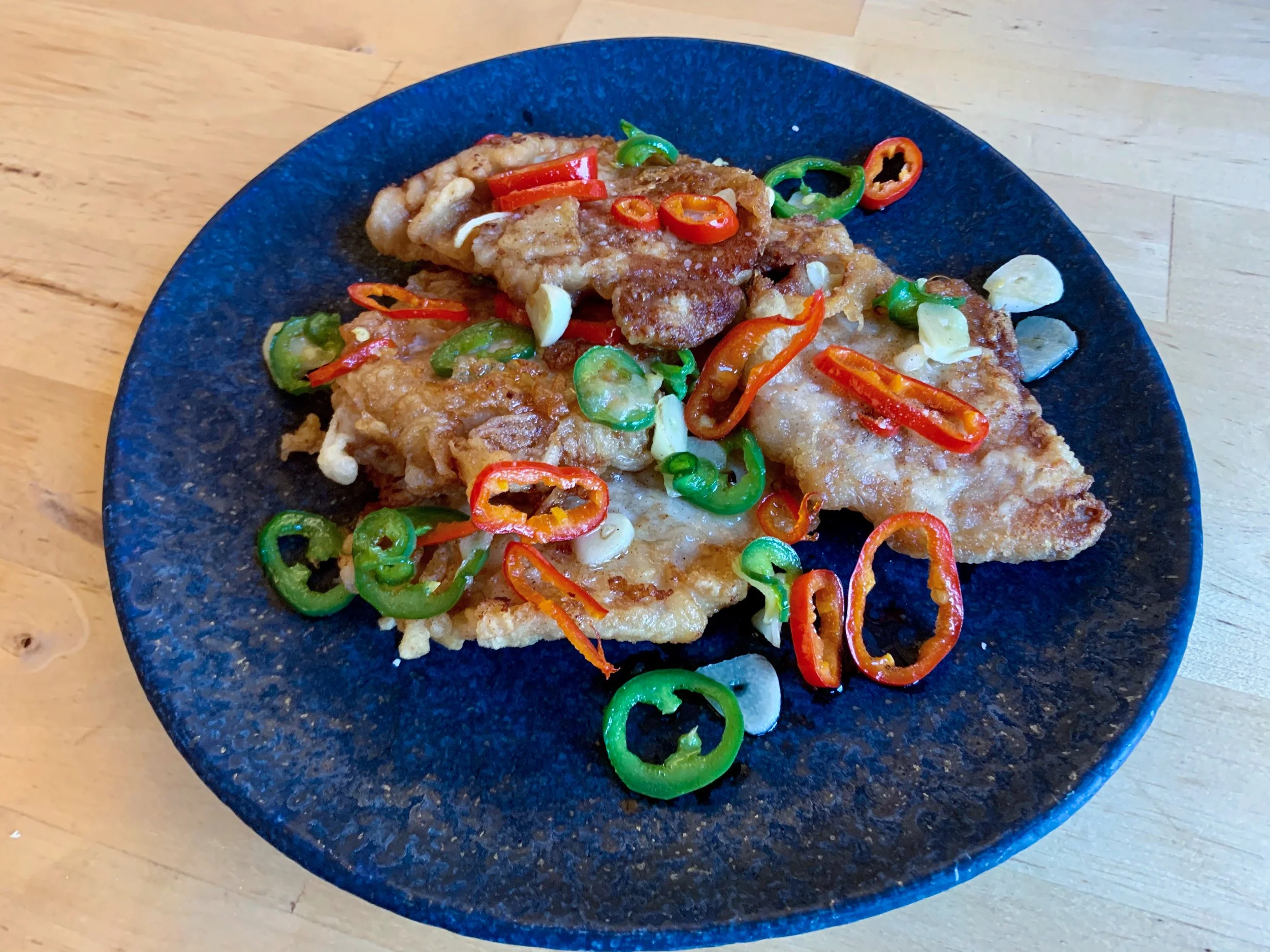Lion's Head Meatballs
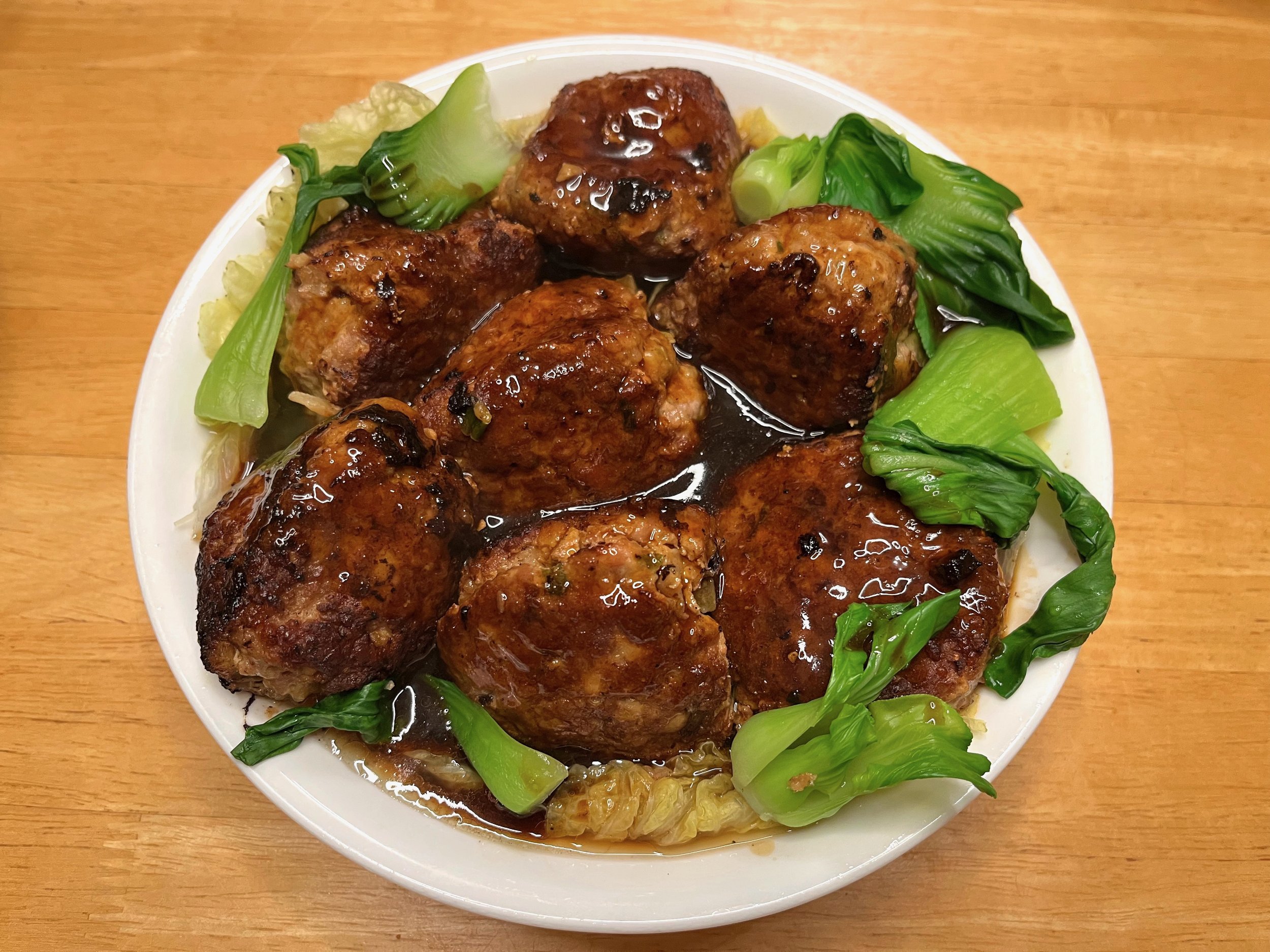
獅子頭 (Shi Zi Tou)
The head of a Chinese guardian lion statue.
Lion’s head—a ferocious name for a mild and tender dish! Large pork meatballs steamed with vegetables, Lion’s head meatballs are commonly associated with Shanghai. However, the dish originated further inland, with the city of Yangzhou having the best claim [1]. The name of the dish comes from the idea that a bowl of the meatballs, ringed by Napa cabbage, resembles the maned head of a lion. Your mileage may vary.
There are a couple of apocryphal stories regarding the invention and naming of lion’s head meatballs. The first involves Emperor Yang of the Sui Dynasty [2], who requested a dish which reminded him of sunflowers. Again, your mileage may vary. Another story claims that the dish was created in honor of a victorious general, who flew a lion banner as his emblem (the 8th century Chinese version of the Beef Wellington story). However, the dish we know today does not definitively appear in the historical canon until the Qing Dynasty [3].
Lion’s head meatballs have a soft texture and are bursting with flavor, and can be served either as a main dish or in a hearty soup. These meatballs also freeze and reheat well.
Ingredients
1 lb ground pork
1 cup panko breadcrumbs
½ cup water chestnuts
½ inch ginger, minced
1 scallion, minced
4 tbsp soy sauce
1 tbsp sesame oil
2 tbsp Shaoxing rice wine
2 eggs
1 tbsp cornstarch
2 tbsp sugar
½ cup vegetable oil
Napa cabbage leaves
6 shiitake mushrooms
1 cup chicken stock
1 tbsp dark soy sauce
Let us begin by preparing the meatball mixture. Add the ground pork to a large mixing bowl, and add the rice wine, sesame oil, 1 tablespoon of sugar, 1 tablespoon of cornstarch, and 3 tablespoons of soy sauce. Finely mince the ginger and scallion before adding them to the mix as well, and crack 2 eggs into the bowl. With a spatula or clean hands, combine these ingredients until smooth.
Dice the water chestnuts into ¼ inch pieces and add them to the mix. Water chestnuts retain their crunch even after cooking, and are in this recipe to provide some textural contrast in the cooked meatball. They do not have to be diced as finely because we do not intend for the chestnuts to disappear, but the pieces cannot be so big as to compromise the structural integrity of the meatball. Fold the chestnuts into the meat until uniformly distributed. Then add one cup of panko breadcrumbs. The breadcrumbs serve several functions—they act as a binder, lighten the texture, and help the meatballs retain moisture. Mix thoroughly, until the mixture is uniform and smooth. The mixture should be very soft and just hold its shape. If it is too runny, add more breadcrumbs. If it seems too dense, lighten the mixture with water or chicken stock, 1 tablespoon at a time.
With the mixture ready, we can now shape the meatballs. Before starting, line a large plate or sheet pan with parchment paper or plastic wrap, so we have a spot to place the shaped meatballs. With clean hands, gently form about 3 tablespoons of the mixture into a sphere. If the mixture sticks, rinse your hands with cold, clean water before forming. When all the meatballs are formed, it is time to fry. Though this is ultimately a steamed dish, frying the meatballs serves two purposes. First, browning the surface will add depth of flavor to the final dish, through the Maillard reaction. Second, the crust formed by frying will help hold the delicate meatball together.
In a nonstick pan, heat about ½ a cup of vegetable oil over medium heat. When the oil is up to temperature, place the meatballs in the pan in a single layer. Leave plenty of maneuvering room between the meatballs, as we will be doing quite a bit of rolling! If your pan isn’t big enough to cook all the meatballs at once, work in batches. Fry for about 2 minutes, until the bottoms of the meatballs are browned and just set. Then carefully roll each meatball to fry a new surface.
Continue rotating until the meatballs are browned on all sides, about 10 minutes of total frying time. Once all the sides are browned, remove the meatballs from the pan. If you want perfectly round meatballs, do what restaurants do and deep fry the meatballs in this step, rather than shallow frying. Another tip for rounder meatballs is to refrigerate them for a couple hours before cooking them. Remember that these meatballs are not fully cooked at this point, so no snacking!
Lion’s head meatballs are traditionally steamed in a clay sand pot, but any heatproof bowl or casserole dish will work. Line the bowl with Napa cabbage leaves, and lay the mushroom slices on the bottom. These mushrooms will absorb the juices released by the meatballs during cooking. Place the meatballs in the bowl, and line the sides of the bowl around the meatballs with additional cabbage and mushroom slices. If you are just cooking these meatballs for freezing, you can skip the vegetables and just steam them in an otherwise empty bowl.
Bring water to boil in the steamer, and place the bowl of meatballs inside. Steam for 40 minutes, until the meatballs are fully cooked. If you don’t own a steamer, use a high-sided bowl which fits into a heavy pot. Put an inch or so of water in the pot and bring it to a boil, then place the bowl directly into the pot.
Lion’s head meatball aren’t always served with a sauce, but a thick, sweet sauce has become common in Shanghainese restaurants. While the meatballs are steaming, we can make this sauce. In a saucepan, combine 1 cup of chicken stock with a tablespoon of soy sauce, a tablespoon of dark soy sauce for color, and 1 tablespoon of brown sugar. Stir and bring to a boil. Prepare a cornstarch slurry with 1 teaspoon of cornstarch and a bit of cold water, and add the slurry to the boiling sauce. Stir well and continue simmering until the sauce reaches nappe consistency, coating the back of a spoon.
To serve the meatballs, remove the bowl from the steamer and lightly glaze the meatballs with the sauce. Because the sauce is quite salty, I prefer to serve a dish of sauce on the side, rather than drowning the meatballs in it. If you’d like to serve the meatballs as a soup, combine the steaming liquid with chicken stock, and bring to a boil. Add vegetables of your choice, bean thread noodles (冬粉), simmer until the noodles are fully cooked, then add the meatballs and serve.
Substitutions
Lion’s head meatballs are often served with bok choy instead of Napa cabbage. You can also choose to add minced shrimp or crab meat to the mix, substituting out an equivalent weight of ground pork. In addition or in lieu of the water chestnuts, you can also consider other “chunks,” such as mushrooms, tofu, or bamboo shoots. However, too many additions will cause the meatball to lose structural integrity. To make the “white” version of this meatball more common in Southern China, replace the soy sauce in the meatball mixture with water and 1 tsp salt.
A less traditional but more convenient way to make these meatballs is to place them on a greased, parchment-lined baking sheet and bake at 400 °F for 30 minutes, or until the internal temperature reaches 160 °F. The meatballs can be flipped or broiled to color them.
[1] It is likely that the dish came to Shanghai during the 19th century, when the city experienced rapid urbanization and thousands of migrants arrived from the inland regions.
[2] 581-618 CE. Yang is considered to be one of the most tyrannical emperors in Chinese history, and his violent overthrow marked the end of the Sui Dynasty.
[3] 1644-1912 CE. Author and historian Xu Ke’s verbose history of the Qing Dynasty, “Qing Bai Lei Chao” (清稗類鈔), contains a recipe for Lion’s head meatballs which would be recognizable today: “Lion's head, is a pork meatball, its shape just as its name implies. The proportion of fat to lean pork is fifty-fifty, chop up them, then mix them with egg whites so that the mixture can coagulate easily. The shrimp meat or crab powder is an optional ingredient to mix. Put Napa cabbage or bamboo shoots on the bottom of a clay pot, pour a little water and dissolve the salt in it. Make the meatballs as big as possible, put them in, then put leaves above the meatballs and put the lid on the pot. Place the pot in a wok filled with salt water, to avoid cracking in this way, cook over a gentle heat. stoke enough firewood at intervals, when the meat is medium, burn the wok fiercely until the meat is well done.”
Recipe
Prep Time: 20 min Cook Time: 50 min Total Time: 1 hr 10 min
Difficulty: 3/5
Heat Sources: 3 burners
Equipment: pan, saucepan, steamer
Servings: 12 meatballs
Ingredients
For the Meatballs
1 lb ground pork
1 cup panko breadcrumbs
½ cup water chestnuts
½ inch ginger, minced
1 scallion, minced
3 tbsp soy sauce
1 tbsp sesame oil
2 tbsp Shaoxing rice wine
2 eggs
1 tbsp cornstarch
1 tbsp sugar
½ cup vegetable oil
Napa cabbage leaves
6 shiitake mushrooms
For the Sauce (optional)
1 cup chicken stock
1 tbsp soy sauce
1 tbsp dark soy sauce
1 tbsp sugar
1 tsp cornstarch
Instructions
1. In a large bowl, combine the ground pork, eggs, 3 tbsp soy sauce, rice wine, sesame oil, 1 tbsp sugar, 1 tbsp of cornstarch, and minced ginger and scallion. Mix until uniform.
2. Add the diced water chestnuts to the mixture, and mix well.
3. Add the panko breadcrumbs, and mix until the mixture becomes uniform and smooth.
4. With clean hands, scoop up about 3 tbsp of the mixture and gently form them into meatballs.
5. In a pan, heat ½ cup of vegetable oil over medium heat. When the oil is up to temperature, place the meatballs in the pan in a single, well-spaced layer. Fry until the bottoms are browned and set (about 2 minutes)
6. Roll each meatball to fry a new surface. Continue rotating until the meatballs are browned on all sides, about 10 minutes total. Remove the par-cooked meatballs from the heat.
7. Line a heatproof bowl or casserole dish with Napa cabbage, and layer some sliced mushrooms on the cabbage. Place the meatballs in the bowl, and line the sides with additional cabbage and mushrooms. Bring water in the steamer to a boil.
8. Steam for 40 minutes, until the meatballs are fully cooked.
9. While the meatballs are steaming, prepare the sauce. In a saucepan, combine 1 cup of chicken stock, 1 tbsp soy sauce, 1 tbsp dark soy sauce, and 1 tbsp sugar. Stir and bring to a boil.
10. When the sauce boils, prepare a cornstarch slurry with 1 tsp of cornstarch, and add it to the sauce to thicken it. Stir well, and remove from the heat when the sauce reaches nappe consistency.
11. Glaze the cooked meatballs with the sauce and serve.
















